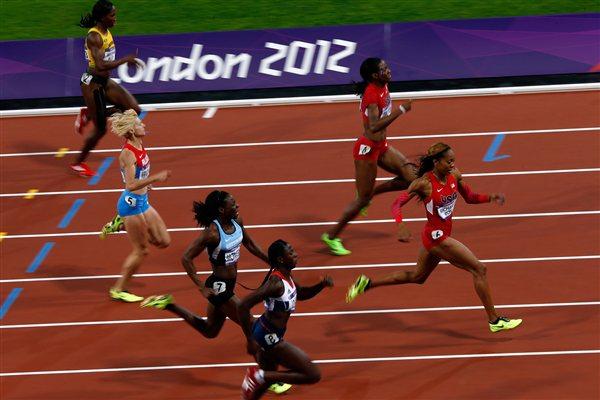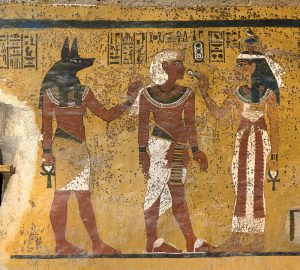Today’s post comes from Andi Ramsay, class of 2018 and Art Center student docent.
The current exhibition in the Art Center’s Focus Gallery is India in Miniature, a collection of small, opaque watercolor paintings, mostly album leaves, from India
Tag Archives: pages.vassar.edu
Race in Professional Sports
As the runners take their places, each waving to the camera as her name is announced, two aspects of the professional athletes’ physical appearance become apparent: one, all the 400 meter runners are incredibly muscled and lithe, and two, there is one single runner with much lighter skin tone than the others. Why do the arenas of certain professional sports appear to be unbalanced? Are people with certain skin colors genetically predisposed to possess greater athletic prowess?

Women’s 400 meter final, London Olympic Games 2012
While some point to genetics, others highlight culture for explanation. In his book Taboo, journalist Jon Entine posits that genetic differences among groups of people, or “races,” predispose certain populations to be better athletes, with minimal cultural influence. However, as Ian Kerr of Western Michigan University rebuts, genetic differences among groups of people do not exclusively account for athleticism. In fact, “scientists cannot find any specific genetic markers that define the characteristics of athleticism (speed, height, strength) in one group or “race” more than any other.” Therefore, while some groups of people may seem to be better at certain sports, such as Kenyan athletes winning the majority of professional long distance running events in the past decade, their athleticism cannot be tied to their skin color. Such superficial classification cannot explain any biological differences that may be thought to account for increased athleticism, because there is no such scientific evidence.

Genomes such as the ones pictured do not reveal a predisposition for athleticism in any group or “race” more than another
Anthropologists and archaeologists have long proved that ancestry does not equate to inferiority or superiority of certain groups of people. According to archaeologist Charles Orser in his work Race and Practice in Archaeological Interpretation, “racialization is a process that seeks to define and compartmentalize the human community on the basis of outward characteristics,” and such a process inevitably leads to “the construction of social inequality.” Genetics do not and cannot validate notions of inferiority or superiority of groups of people. To do so, as civil rights lawyer Vinay Harpalani argues, one would have to prove that, in the case of skin tone in sports: “1) there is a systematic way to define Black and White populations; 2) consistent and plausible genetic differences between the populations can be demonstrated; 3) a link between those genetic differences and athletic performance can be clearly shown.” Harpalani’s three-step system is scientifically unprovable, thereby dismissing claims that certain populations are inherently superior to others.
Therefore, using principles of bioarchaeology, or the analysis of past human remains to understand their larger culture, the belief in the superiority or inferiority of certain populations is debunked. Differences among groups are due to environmental factors, or training, in the case of sports. While cultural pride at times seems to stem from physical differences, true cultural pride should rise from mostly social, cognitive, and traditional roots. Therefore, when next the runners take their marks, they should not focus on the color of their competitors’ skin, but instead on their skill.
Further Reading
- Race and Racism in Archaeology, by Chris Gosden: https://www.jstor.org/stable/40023591?seq=1#page_scan_tab_contents
- The Myth of Racial Superiority in Sports, by Ian B. Kerr: http://scholarworks.wmich.edu/cgi/viewcontent.cgi?article=1027&context=hilltopreview
Sources
- http://scholarworks.wmich.edu/cgi/viewcontent.cgi?article=1027&context=hilltopreview
- Orser, Charles E. Race and Practice in Archaeological Interpretation (2004)
- http://anthropology.columbia.edu/department-history/franz-boas
Images
The Art of Devastation: World War I Medals and Posters Exhibition
Today’s post comes from Hannah Cho, class of 2018 and Art Center multimedia assistant.
The Art Center’s most recent exhibition features beautiful medals and posters from the Great War
Bioarchaeology Helps Shed New Light on Ancient Mysteries
Since Howard Carter unveiled the tomb of the ancient Egyptian Pharaoh Tutankhamen in 1922, the world has been fascinated with the king. One major question surrounding Tut is the circumstance of his sudden death. Using bioarchaeology, archaeologists may have found a conclusive answer.
From examining Tut’s body along with written records, it’s evident that Tut died around 19 years old and his burial was rushed and unexpected. The tomb is small for a pharaoh, so Egyptologists speculate that it wasn’t originally intended for Tut, but they needed to bury him quickly (more on this that may lead to new discoveries in the link at the bottom). Bioarchaeology confirms Tut’s hurried burial. Mold-like spots appear on the tomb walls, and comparison of old and new photographs prove they haven’t changed since 1922, suggesting the spots are ancient. Recent microbial analysis confirms this by showing that the spots contain melanins, a sign of the metabolism of fungus, but no living microbes were found. The environment of the walls’ wet paint combined with foodstuffs buried with Tut would’ve created the perfect environment for microbial growth, resulting in the spots.
What could be the reason for Tutankhamen’s early and unexpected demise? Many have speculated about murder, a chariot accident, and even an unfortunate hippopotamus encounter. However, the bioarchaeology tells a much less dramatic story. Previously, the chariot accident was the leading theory on Tut’s death, as some chariots were buried with him and according to his mummy’s early CT scans, he suffered a fatal blow to the head. Bioarchaeologists debunked this theory when they determined Tut’s head injury was post-mortem (after death), probably sustained either in the mummification process or the mishandling of the body by Carter’s team. Also, bioarchaeology reveals from new CT scans that king Tut couldn’t even stand on a chariot, let alone ride one, as he had a clubfoot. In his tomb, archaeologists found 130 used walking canes, supporting the analysis that Tut needed a cane to walk.
The reason for his deformities? King Tut was born out of incest. Genetic testing of Tut and other mummies confirms that his father and mother were full siblings (further details of this found in the link at the bottom). While incest to keep the royal bloodline pure was not uncommon, it could have disastrous effects for the offspring, like Tut.

A 3-D rendition of what Tut would’ve have looked like during his lifetime, based on updated and extensive CT scans of his mummy
A clubfoot and an incestuous birth wouldn’t have been enough to kill Tut, but it would’ve weakened his immune system. Bioarchaeology’s analysis of Tut’s body found signs that he contracted malaria, possibly many times during his life. Tut possibly had some immunity to malaria because of his geographical location, but with Tut’s weakened immune system combined with a leg fracture (with possible complications), it’s likely that the disease killed him.
Pop culture depicts King Tutankhamen as a mysterious king under a golden mask who tragically died young, but bioarchaeology shows the real picture: a deformed teenager, barely able to walk, suffering from malaria and the effects of incest.
Sources:
http://www.livescience.com/14525-spots-tut-burial-rushed.html
http://www.smithsonianmag.com/smart-news/newest-king-tut-theory-he-suffered-severe-disorders-due-inbreeding-180953113/
http://news.nationalgeographic.com/news/2010/02/100216-king-tut-malaria-bones-inbred-tutankhamun/
Further details of genetic testing: http://ngm.nationalgeographic.com/print/2010/09/tut-dna/hawass-text
Further Reading:
On the Life of Akhenaten (Tut’s likely father): https://www.britannica.com/biography/Akhenaten
On the debate of hidden chambers in Tut’s tomb: http://news.nationalgeographic.com/2016/05/160509-king-tut-tomb-chambers-radar-archaeology/
Image Sources:
Tut’s tomb southern wall: http://www.livescience.com/images/i/000/017/169/original/king-tut-spots-2.jpg?interpolation=lanczos-none&downsize=*:1000
Tut body recreation: http://www.archeolog-home.com/medias/images/dnews-files-2014-10-king-tut-reconstruction-141020-jpg.jpg
My Friends at the Museum – Art that Speaks
Today’s post comes from Bella Dalton-Fenkl, class of 2020 and Art Center Student Docent.
I remember one day last term when I arrived at the Art Center and was met with a surprise—I had to give a tour to fifty people

